The kynurenine pathway in stem cell biology
- PMID: 24092986
- PMCID: PMC3782398
- DOI: 10.4137/IJTR.S12626
The kynurenine pathway in stem cell biology
Abstract
The kynurenine pathway (KP) is the main catabolic pathway of the essential amino acid tryptophan. The KP has been identified to play a critical role in regulating immune responses in a variety of experimental settings. It is also known to be involved in several neuroinflammatory diseases including Huntington's disease, amyotrophic lateral sclerosis, and Alzheimer's disease. This review considers the current understanding of the role of the KP in stem cell biology. Both of these fundamental areas of cell biology have independently been the focus of a burgeoning research interest in recent years. A systematic review of how the two interact has not yet been conducted. Several inflammatory and infectious diseases in which the KP has been implicated include those for which stem cell therapies are being actively explored at a clinical level. Therefore, it is highly relevant to consider the evidence showing that the KP influences stem cell biology and impacts the functional behavior of progenitor cells.
Keywords: 3-dioxygenase; embryonic stem cell; haematopoietic stem cell; indoleamine 2; kynurenine pathway; mesenchymal stem cell; neural stem cell; tryptophan.
Figures


References
-
- Ruddick JP, Evans AK, Nutt DJ, Lightman SL, Rook GA, Lowry CA. Tryptophan metabolism in the central nervous system: medical implications. Expert Rev Mol Med. 2006;8(20):1–27. - PubMed
-
- Tan L, Yu JT, Tan L. The kynurenine pathway in neurodegenerative diseases: Mechanistic and therapeutic considerations. J Neurol Sci. 2012;323(1–2):1–8. - PubMed
-
- Indoleamine 2,3-dioxygenase. A new vista in tryptophan metabolism. Acta Vitaminol Enzymol. 1975;29(1–6):17–20. - PubMed
-
- Ball HJ, Sanchez-Perez A, Weiser S, et al. Characterization of an indoleamine 2,3-dioxygenase-like protein found in humans and mice. Gene. 2007;396(1):203–13. - PubMed
-
- Shimizu T, Nomiyama S, Hirata F, Hayaishi O. Indoleamine 2,3-dioxygenase. purification and some properties. J Biol Chem. 1978;253(13):4700–6. - PubMed
Publication types
LinkOut - more resources
Full Text Sources
Other Literature Sources

